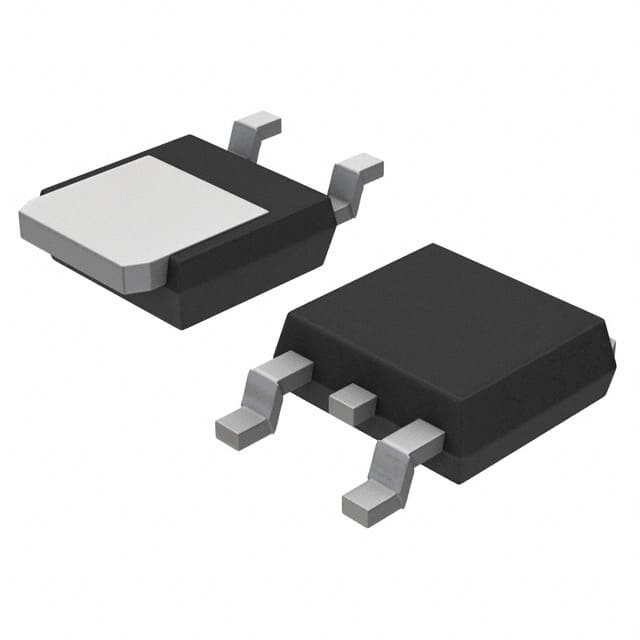Lihat spesifikasi untuk detail produk.

MJD2955G
Introduction
The MJD2955G is a power transistor belonging to the category of Bipolar Junction Transistors (BJTs). It is commonly used in electronic circuits for amplification and switching applications due to its high current and voltage capabilities. This entry provides an overview of the MJD2955G, including its basic information, specifications, pin configuration, functional features, advantages and disadvantages, working principles, application field plans, and alternative models.
Basic Information Overview
- Category: Bipolar Junction Transistor (BJT)
- Use: Amplification and switching in electronic circuits
- Characteristics: High current and voltage capabilities
- Package: TO-252
- Essence: Power transistor for electronic applications
- Packaging/Quantity: Typically available in reels or tubes containing multiple units
Specifications
- Collector-Emitter Voltage (VCEO): 60V
- Collector-Base Voltage (VCBO): 80V
- Emitter-Base Voltage (VEBO): 5V
- Collector Current (IC): 10A
- Power Dissipation (PD): 2W
- Transition Frequency (fT): 2MHz
Detailed Pin Configuration
The MJD2955G has a standard TO-252 package with three pins: 1. Collector (C): Connected to the positive supply voltage in typical circuit configurations. 2. Base (B): Controls the transistor's conductivity when a small current is applied. 3. Emitter (E): Connected to the ground in typical circuit configurations.
Functional Features
- High current gain and power dissipation capability
- Low saturation voltage, enabling efficient switching
- Fast switching speed for rapid response in electronic circuits
Advantages and Disadvantages
Advantages
- High current and voltage ratings
- Suitable for power applications
- Compact TO-252 package for easy integration into circuits
Disadvantages
- Relatively high power dissipation
- Limited frequency response compared to other transistor types
Working Principles
The MJD2955G operates based on the principles of bipolar junction transistors, where the flow of current between the collector and emitter is controlled by the base current. By modulating the base current, the transistor can amplify signals or act as a switch in electronic circuits.
Detailed Application Field Plans
The MJD2955G is widely used in various electronic applications, including: - Power amplifiers - Motor control circuits - Voltage regulators - Switching power supplies - LED drivers
Detailed and Complete Alternative Models
Some alternative models to the MJD2955G include: - TIP3055: Similar power transistor with a different package (TO-218) - 2N3055: Widely used power transistor with higher power dissipation capability - MJ15003: High-power complementary transistor pair for audio amplifier applications
In conclusion, the MJD2955G is a versatile power transistor suitable for a wide range of electronic applications, offering high current and voltage capabilities in a compact TO-252 package.
Word Count: 411
Sebutkan 10 pertanyaan dan jawaban umum terkait penerapan MJD2955G dalam solusi teknis
What is the maximum collector current of MJD2955G?
- The maximum collector current of MJD2955G is 10A.
What is the maximum collector-emitter voltage of MJD2955G?
- The maximum collector-emitter voltage of MJD2955G is 60V.
What is the typical DC current gain (hFE) of MJD2955G?
- The typical DC current gain (hFE) of MJD2955G is 20-70.
What are the typical applications of MJD2955G?
- MJD2955G is commonly used in power management and switching applications, such as voltage regulators, motor control, and power amplifiers.
Is MJD2955G suitable for high-power applications?
- Yes, MJD2955G is suitable for high-power applications due to its high collector current rating.
What is the thermal resistance of MJD2955G?
- The thermal resistance of MJD2955G is typically around 3°C/W.
Can MJD2955G be used in automotive applications?
- Yes, MJD2955G is often used in automotive systems, including electronic control units and power management modules.
Does MJD2955G require a heat sink in high-power applications?
- Yes, it is recommended to use a heat sink with MJD2955G in high-power applications to ensure proper thermal management.
What are the package options available for MJD2955G?
- MJD2955G is available in various packages, including TO-252, DPAK, and D2PAK.
Are there any specific considerations for driving MJD2955G in a circuit?
- It's important to ensure proper base drive and heat dissipation when using MJD2955G in a circuit to maximize its performance and reliability.

